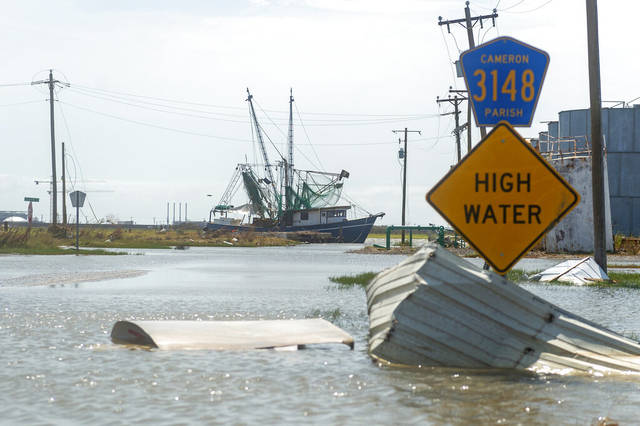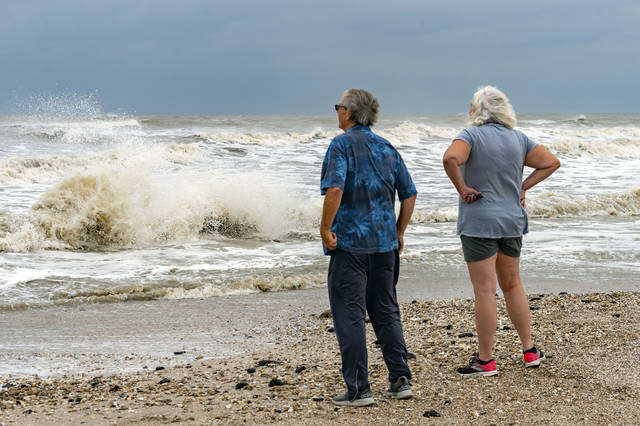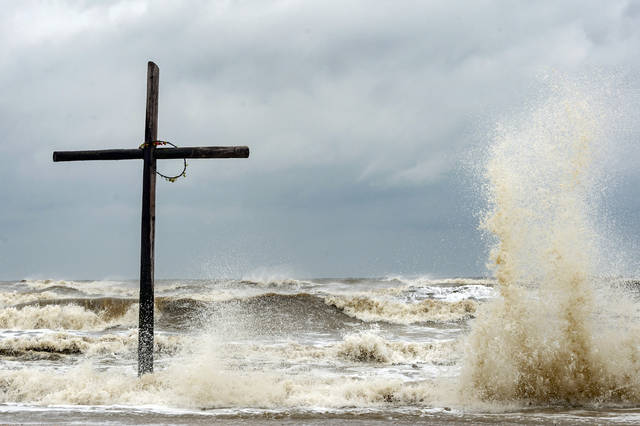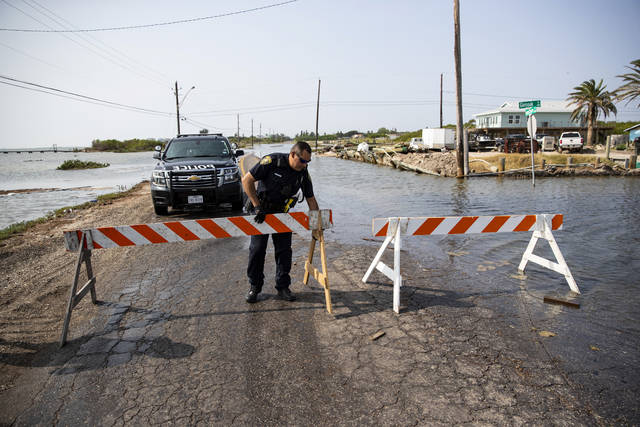Biggest unknown with Tropical Storm Beta is how much rain it will bring
HOUSTON — As Tropical Storm Beta neared the Texas coast Monday, the biggest unknown was how much rainfall it could produce in areas that have already seen their share of damaging weather during a busy hurricane season.
Beta’s winds were weakening as it got closer to making landfall sometime Monday evening and the storm was not expected to strengthen into a hurricane. But its path along the Texas coast over the next couple of days once it gets inland could produce bands of showers with heavy rainfall, forecasters said. Rain from Beta was already coming down Monday in the Houston area.
“This still is probably the most uncertain part of the forecast,” Dan Reilly, a meteorologist with the National Weather Service in the Houston-Galveston office, said about rainfall from Beta.
Earlier predictions of up to 20 inches in some areas were downgraded Monday to up to 15 inches. Texas coastal counties were most likely to see 4 to 6 inches with 2 to 4 inches farther inland, Reilly said.
Forecasters and officials reassured residents Beta was not expected to be another Hurricane Harvey or Tropical Storm Imelda. Harvey in 2017 dumped more than 50 inches of rain on Houston, causing $125 billion in damage in Texas. Imelda, which hit Southeast Texas last year, was one of the wettest cyclones on record.
Beta’s maximum sustained winds were 45 mph Monday afternoon. Beta was moving west-northwest at 7 mph at about 1 p.m., forecasters said. It was about 45 miles southeast of Port O’Connor, Texas.
NEW: The newest forecast cone for #Beta suggests after the storm makes landfall in Texas, it will go back out into the Gulf of Mexico before making a *second* landfall in Louisiana. pic.twitter.com/fJu5NRFJkh
— The Weather Channel (@weatherchannel) September 21, 2020
Storm surge up to 4 feet was forecast from Port Aransas to Sabine Pass in Texas.
After Beta makes landfall, it is expected to move northeast along the coast and head into Louisiana sometime mid-week, forecasters said. Flash flooding was possible in Arkansas and Mississippi as the system moves farther inland.
In Galveston, an island city southeast of Houston, there was already some street flooding from rising tides and part of a popular fishing pier collapsed due to strong waves.
Farther south on the Texas coast, Maria Serrano Culpepper along with her two daughters and dogs left their home Sunday night as Beta was predicted to make landfall in nearby Matagorda Bay.
Culpepper said she didn’t want to be trapped in her home, three blocks from the beach, with wind, rain and possibly no electricity. She and her family evacuated to a friend’s home in nearby Victoria.
Culpepper said her home should be fine as it’s on stilts 13 feet off the ground and was built to withstand strong storms.
“I’m feeling OK now. I had two nights without sleeping because I was worried about (Beta) being a Category 1 hurricane. I calmed down when the storm lost power,” said Culpepper, who works as an engineer at a nearby chemical plant.
On Monday, Gov. Greg Abbott issued a disaster declaration for 29 Texas counties ahead of Beta’s arrival.
Forecasters ran out of traditional storm names on Friday, forcing the use of the Greek alphabet for only the second time since the 1950s.
Beta is forecast to dump heavy rain on the southwestern corner of Louisiana three weeks after the same area got pounded by Hurricane Laura. The rainfall and storm surge prompted Louisiana Gov. John Bel Edwards to declare a state of emergency.
Beta would be the ninth named storm to make landfall in the continental U.S. this year. That would tie a record set in 1916, according to Colorado State University hurricane researcher Phil Klotzbach.
Parts of the Alabama coast and Florida Panhandle were still reeling from Hurricane Sally, which roared ashore Wednesday, causing at least two deaths. Two Boston-based disaster modeling firms figured Sally caused about $2 billion in privately insured losses from wind and storm surge. Karen Clark & Company estimated losses at $2 billion, while AIR Worldwide said they were between $1 and $3 billion. The estimates don’t include uninsured losses, the National Flood Insurance Program claims or damage to offshore property, like oil rigs.
Hurricane Teddy was about 165 miles east of Bermuda on Monday afternoon as it heads toward Nova Scotia. It had maximum sustained winds of 90 mph and was moving north-northeast at 18 mph and away from the wealthy British territory, according to the National Hurricane Center in Miami.
The government closed all air and sea ports, schools and government offices for the second time in a week. Hurricane Paulette made landfall in Bermuda on Sept. 14, knocking down trees and leaving thousands without power.
Remove the ads from your TribLIVE reading experience but still support the journalists who create the content with TribLIVE Ad-Free.




